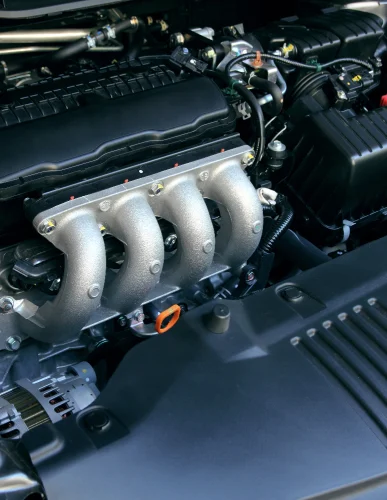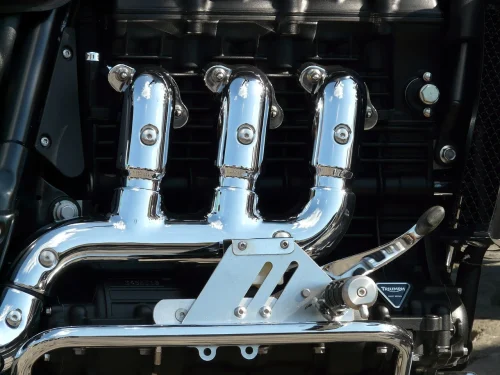
Fundamental Fields of Acoustics
December 9, 2024
Automotive Sensors Design
January 2, 2025
Fundamental Fields of Acoustics
December 9, 2024
Automotive Sensors Design
January 2, 2025Designing an exhaust header is crucial for optimizing engine performance. This guide provides a step-by-step approach, including the necessary equations and practical examples.
An exhaust header is an aftermarket component designed to replace the stock exhaust manifold in an engine. Here’s a breakdown of what it is and its purpose:
- Scavenging Effect: The process of efficiently removing spent exhaust gases from the engine cylinder and replacing them with a fresh air-fuel mixture.
- Exhaust Pulses: High-speed pulses are created by the rapid movement of exhaust gases, which can create a vacuum effect to aid in scavenging.
The scavenging effect is a critical aspect of exhaust system design, particularly in high-performance engines. It refers to the process of efficiently removing spent exhaust gases from the engine cylinder and replacing them with a fresh air-fuel mixture. This process is essential for maintaining engine performance and efficiency.
What is an Exhaust Header?
An exhaust header is an aftermarket component designed to replace a vehicle's standard exhaust manifold. Its primary function is to improve the exhaust system's efficiency, which can enhance engine performance.
- Function: The primary function of an exhaust header is to improve the flow of exhaust gases from the engine cylinders to the exhaust system. Unlike the stock exhaust manifold, which is typically made of cast iron and has a more restrictive design, headers are designed to reduce back pressure and improve engine performance
- Design: Headers are usually made from materials like stainless steel, mild steel, or titanium, making them lighter and more durable than stock manifolds. They feature individual tubes for each cylinder that merge into a single collector, allowing exhaust gases to exit more efficiently
- Performance: By reducing back pressure and improving exhaust flow, headers can increase horsepower and torque. They are particularly beneficial for high-performance and racing applications.
Why Using Headers
- Increased Horsepower: Headers can significantly boost engine power by allowing exhaust gases to flow more freely.
- Reduced Back Pressure: The design of headers minimizes back pressure, which can improve engine efficiency and performance.
- Enhanced Sound: Headers often produce a more aggressive exhaust note, which is desirable for many car enthusiasts
How Scavenging Works?
Here’s a detailed look at how it works and its relation to exhaust system dimensions:
- Exhaust Stroke: During the exhaust stroke, the exhaust valve opens, and the piston pushes the spent gases out of the cylinder.
- Pressure Differential: The high pressure inside the combustion chamber compared to the lower pressure in the exhaust manifold helps to expel the gases.
- Exhaust Pulses: The rapid movement of exhaust gases creates high-speed pulses. These pulses can create a vacuum effect that helps draw out the remaining gases and pull in fresh air-fuel mixture during the valve overlap period.
Exhaust Manifolds Vs Exhaust Headers
- Exhaust Manifolds: Typically made from cast iron, they are designed for durability and cost-effectiveness but can be restrictive in terms of airflow.
- Headers: Made from lighter materials with a design focused on performance, they offer better airflow and reduced back pressure.

OEM Exhaust Manifold
Practical Considerations
- Equal-Length Headers: Using equal-length headers ensures that exhaust pulses from each cylinder arrive at the collector at evenly spaced intervals, improving scavenging efficiency.
- X-Pipes and H-Pipes: These configurations help balance exhaust pulses between the two banks of a V-engine, enhancing scavenging and reducing back pressure.
- Tuning for Specific Applications: The optimal exhaust pipe length depends on the intended use of the vehicle. For example, a vehicle designed for high-speed racing might benefit from shorter pipes, while one intended for off-road or towing might perform better with longer pipes.
- Balancing Performance: In many cases, a balance between pipe length and diameter is necessary to achieve a good compromise between low-end torque and high-end power.
Adjusting the exhaust pipe length from the calculated optimal value can significantly impact the scavenging effect and overall engine performance. Here’s how:
Increasing the Exhaust Pipe Length
- Low-End Torque Improvement: Longer exhaust pipes can enhance low-end torque by improving the scavenging effect at lower RPMs. This is because the longer pipes allow the exhaust pulses to travel further, creating a stronger vacuum effect that helps draw out exhaust gases more effectively at lower engine speeds.
- Reduced High-End Power: However, longer pipes may reduce high-end power. The extended length can cause the exhaust pulses to lose energy before they reach the collector, diminishing the scavenging effect at higher RPMs.
Decreasing the Exhaust Pipe Length
- High-End Power Enhancement: Shorter exhaust pipes are generally better for high-end power. They allow the exhaust pulses to reach the collector more quickly, maintaining their energy and improving the scavenging effect at higher RPMs.
- Reduced Low-End Torque: On the downside, shorter pipes may reduce low-end torque. The shorter length can result in less effective scavenging at lower engine speeds, as the exhaust pulses do not have enough time to create a strong vacuum effect.
Exhaust Header Design Equations
The equations below are for primary evaluation of the header dimensions and not for professional use. Professionals use professional software to perform iterative simulations and testing to verify and validate the value added from the new exhaust header. It is important to know that the headers are tuned to a specific RPM where you want to get the most performance out of your engine.
Step 1: Determine Engine Specifications
- Engine Speed (RPM): Identify the target RPM range for optimization.
- Volumetric Efficiency (VE): Estimate the engine's volumetric efficiency.
- Speed of Sound (c): Use the speed of sound in the exhaust gas.
Step 2: Calculate the Optimal Exhaust Header Length
To calculate the optimal length for the entire exhaust header system. Use the formula:
L=C/2RPM x 60
Step 3: Calculate Primary Header Length
To calculate the optimal length of the primary tubes. Use the formula
Lp=(850xVE)/RPM
Step 4: Primary Header Pipe Diameter
The header pipe diameters should be calculated to avoid any back pressure on the engine.
We need first to calculate the cross-section area of the pipe in inch square
PPA=(RPM/88200) x Single Cylinder Volume
Inner Diameter of the pipe [inch]
Din=Sqrt(PPA x 4/pi)
Step 5: Adjust for Practicality
If the calculated lengths are not feasible, use harmonic tuning to find shorter or longer lengths that still provide effective scavenging.
Practical Length = Lp/n , n=2,4,8...etc.
Add the thickness of the pipe to calculate the Outer Diameter of the pipe, or select the pipe using the inner diameter size from the pipe vendors in the market.
Dout=Din + 2x thickness
Step 6: Fabricate and Measure
- Fabricate the Primary Tubes using the calculated dimensions.
- Fabricate the Collector and Secondary Pipes.
- Measure the car performance at the tuned speed on a Dyno, and compare it with old horsepower and speed.
- Measure the Exhaust Sound Pressure levels with the new exhaust header.
Conclusion
By following these steps and using the provided equations, you can understand how an exhaust header can optimize the scavenging effect and enhance engine performance. If you are considering replacing your manifold or exhaust headers, contact us to design and tune it for your engine.
Contact Us
We'd love to hear from you! Whether you have questions, need a consultation, or want to discuss a project, feel free to reach out.


